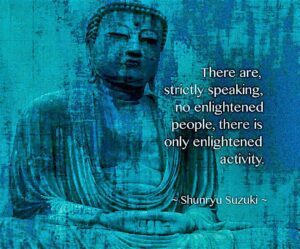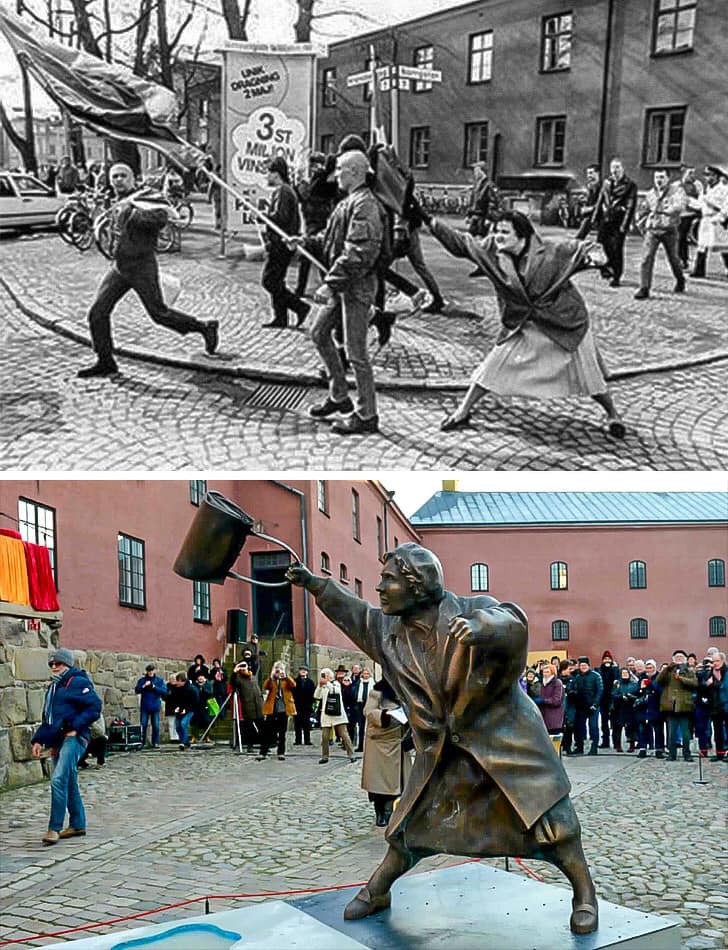In Sweden, there is a fascinating statue of a woman named Danuta Danielsson who became a hero in 1985 when she used her purse to clobber a white Nazi supremacist while he marched in a right-wing rally.
What makes her statue unique among hero statues is that it captures her performing the heroic act of swinging her purse. It’s entirely an action-shot, a big departure from the universal practice of constructing hero statues intended to portray individuals as heroes. Danielsson’s statue isn’t about her as a person; it’s about her one specific act of courage that day.
Heroism, it could be argued, describes an action, not a person.
All around the world, and especially in the United States, statues of slave traders, warriors, and profiteers are toppling to the ground. Once revered as heroes, these statued individuals have been exposed as villainous human rights violators.
With this in mind, Danuta Danielsson’s statue should be one that remains uncontroversial. Her statue portrays a heroic act that can withstand any scrutiny into her character.
What did we know about Danielsson’s character? We know that her mother had survived a concentration camp during World War II. Danielsson knew the horrors of the Nazi menace and took action on that April day in Sweden.
But like all human beings, Danielsson had a dark side. That aspect of her character, however, is irrelevant to her heroic act of clobbering a marching Nazi, an image nicely captured by her statue in vivid heroic detail.
Perhaps there should be no hero statues, only heroic action statues. Many of our tarnished heroes performed untarnished heroic actions. It’s those behaviors that we admire, those courageous, risky, selfless actions that forever made a positive difference for society.
For example, let’s see a statue of Thomas Jefferson composing the Declaration of Independence.  Such a statue acknowledges Jefferson’s heroic action without any idolatry of the man, without any of vitriol about whether he’s deserving of the status of “hero”.
Such a statue acknowledges Jefferson’s heroic action without any idolatry of the man, without any of vitriol about whether he’s deserving of the status of “hero”.
Today we see statues of Confederate generals, Christopher Columbus, slave traders, and Spanish conquistadors toppling to the ground. Roads and schools named after these individuals are also being changed. We are reminded that a hero is a social construction, tied to the norms and values of a particular era.
Heroic actions, in contrast, are more likely to transcend human time periods. While all humans are flawed and perhaps not deserving of adoration, a morally sublime act is pure and transcendent.
The famous German author and poet Johann Wolfgang von Goethe once wrote, “The deed is everything, the glory is naught.” In building our statues, let’s remember that actions not only speak louder than words, they may outshine — and outlast — the person performing the action.
Shunryu Suzuki, the famed Zen monk and teacher, once said that there are no enlightened people. There are only enlightened actions.
 It seems obvious that enlightenment or lack of enlightenment, whether in a person or in an action, is better viewed as a continuum rather than as an all-or-nothing quality. Some people and some actions reflect more enlightenment than others. Seeing subtlety and nuance is a hallmark trait of heroic consciousness.
It seems obvious that enlightenment or lack of enlightenment, whether in a person or in an action, is better viewed as a continuum rather than as an all-or-nothing quality. Some people and some actions reflect more enlightenment than others. Seeing subtlety and nuance is a hallmark trait of heroic consciousness.
People are more likely to disagree about who a hero is than about what specific action is heroic. For that reason, let’s honor and celebrate heroic actions that can inspire us all to behave heroically.
– –
Scott T. Allison is Professor of Psychology at the University of Richmond. Another version of this article appears in Psychology Today.
– – – – – – – – – –
